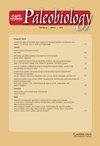中始新世晚期至渐新世早期(~40 ~ 31 Ma)球石群Reticulofenestra演化的营养强迫
IF 2.7
2区 地球科学
Q2 BIODIVERSITY CONSERVATION
引用次数: 0
摘要
在早渐新世(~32 Ma)发现的Reticulofenestra-Gephyrocapsa-Emiliania (RGE)谱系(Isochrysidales目)的第一次尺寸缩小(FSR),对于理解晚始新世至今影响球石菌群落的利力浦特效应具有重要意义。本文利用南大西洋海相沉积物,对生活在中始新世晚期至渐新世早期(~40 ~ 31 Ma)的Reticulofenestra种的球粒岩进行了形态分析。始新世晚期,大型种的尺寸增大,丰度减少,导致它们在FSR处消失,而中小型种的尺寸变异性也随之减小,其中心开口直径变得非常小。虽然从古近纪到新近纪世界性的球石藻尺寸减小与伴随的全球二氧化碳分压的长期下降有关,但我们认为,FSR是始新世晚期与南极冰层堆积相关的翻转环流建立后,富营养化环境扩张导致的环境不稳定的结果。这项研究还使我们提出了一个假设模型,该模型将RGE谱系物种的球粒形态与上层海洋的营养资源联系起来:具有较小球粒中心开口的小型至中型、r选择的球粒藻生活在营养丰富的水域,主要依靠光合作用,很少依靠混合营养,而具有较大球粒中心开口的大型、k选择的物种生活在少营养水域,更依赖混合营养。本文章由计算机程序翻译,如有差异,请以英文原文为准。
Inferred nutrient forcing on the late middle Eocene to early Oligocene (~40–31 Ma) evolution of the coccolithophore Reticulofenestra (order Isochrysidales)
The first size reduction (FSR) in the Reticulofenestra-Gephyrocapsa-Emiliania (RGE) lineage (order Isochrysidales), which occurred in the early Oligocene (~32 Ma), is of great significance for understanding the Lilliput effect that has affected coccolithophore communities from the late Eocene to this day. We conducted a morphologic analysis on the coccoliths of Reticulofenestra species that lived during the late middle Eocene to early Oligocene (~40–31 Ma), using marine sediments from the South Atlantic Ocean. Our data show increasing size and decreasing abundance of the large species during the late Eocene, leading to their disappearance at the FSR, and a concurrent decrease in the size variability of the small- to medium-sized coccoliths whose central opening diameter had become very reduced. Although the cosmopolitan late Paleogene through Neogene size decrease in coccolithophores has been linked to the concomitant long-term decline in global pCO2, we suggest here that the FSR was the result of environmental destabilization caused by the expansion of eutrophic environments following the late Eocene establishment of overturning circulation associated with ice buildup on Antarctica. This study also leads us to propose a hypothetical model that links coccolith morphology of species of the RGE lineage and trophic resources in the upper ocean: the small- to medium-sized, r-selected coccolithophores with smaller coccolith central openings live in nutrient-rich waters where they rely mostly on photosynthesis and little on mixotrophy, whereas the larger, K-selected species with larger coccolith central openings live in oligotrophic waters where they are more dependent on mixotrophy.
求助全文
通过发布文献求助,成功后即可免费获取论文全文。
去求助
来源期刊

Paleobiology
地学-古生物学
CiteScore
5.30
自引率
3.70%
发文量
38
审稿时长
>12 weeks
期刊介绍:
Paleobiology publishes original contributions of any length (but normally 10-50 manuscript pages) dealing with any aspect of biological paleontology. Emphasis is placed on biological or paleobiological processes and patterns, including macroevolution, extinction, diversification, speciation, functional morphology, bio-geography, phylogeny, paleoecology, molecular paleontology, taphonomy, natural selection and patterns of variation, abundance, and distribution in space and time, among others. Taxonomic papers are welcome if they have significant and broad applications. Papers concerning research on recent organisms and systems are appropriate if they are of particular interest to paleontologists. Papers should typically interest readers from more than one specialty. Proposals for symposium volumes should be discussed in advance with the editors.
 求助内容:
求助内容: 应助结果提醒方式:
应助结果提醒方式:


